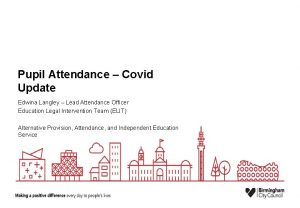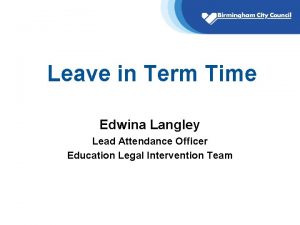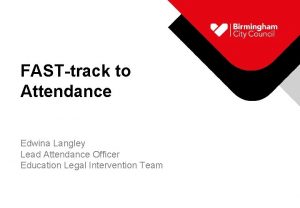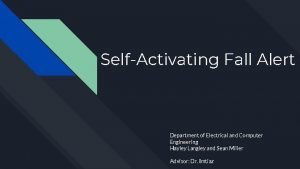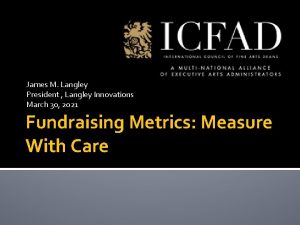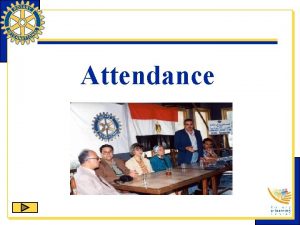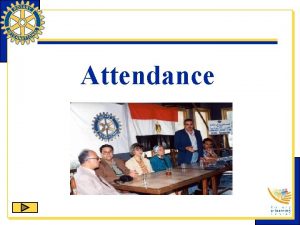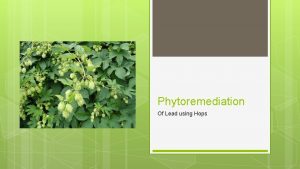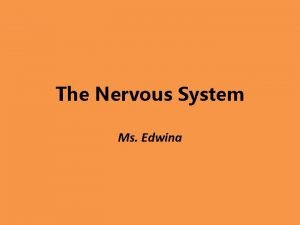FASTtrack to Attendance Edwina Langley Lead Attendance Officer















- Slides: 15

FAST-track to Attendance Edwina Langley Lead Attendance Officer Education Legal Intervention Team

The Law • Parents are responsible for making sure that their children of compulsory school age receive efficient full-time education that is suitable to the child’s age, ability and aptitude and to any special educational needs the child may have. • This can be by regular attendance at school, alternative provision, or otherwise (e. g. the parent can choose to educate their child at home). Section 7, Education Act 1996

Why Fast-Track? • Early Help offered • Voice of the Child – (Daniel Pelka, Tia Sharp, Ellie Butler) • Legal action – a last resort • Engagement from schools • Training not required (though preferred)

Criteria for Fast-Track • Compulsory school age pupils • Concerning levels of absence either authorised or not • NOT include Looked After Children

Pupil with concerning levels of absence Check reasons for absence ‘Signs of Safety and Wellbeing’ Non-cooperation If unauthorised absence – go to Step 2 Additional concerns Early Help assessment / Think Family / MASH and discuss with Court Section (via email)

Step One Early Help Concerning levels of absence either authorised or unauthorised – (once a year schools should send the ‘School Attendance’ whole school letter to parents by pupil post, email, or by placing it on their website/in their prospectus) Action the school must take before a referral to ELIT can be made

School Absence Procedures Essential • First day calling • Sending a letter • Home visit • ‘Children with a safeguarding vulnerability’ list • ‘Signs of Safety & Wellbeing’ – voice of the child • Informal meeting • Request for medical evidence (only in cases of concern) • Time limited interventions

Early Help • Right Help, Right Time – Signs of Safety and Wellbeing – Early Help Panel – Early Help Assessment – CASS ‘Request for Support’ form/Phone Consultation • Children Missing from Education team (formally LSNT) • School Nurse (Public Health) • James Brindley • FAST-Track

3 Steps to delivering Early Help in Education 1. Identify children/ Young people with unmet safeguarding needs (RSRT changing to RHRT) 2. Enable the child`s voice by evidencing their lived experience ( 3 houses) 3. Assess current needs and choose an Early Help action


Tackling illness • • • Trust your parents! Do not routinely ask for medical evidence Consider NHS capacity! Include in your policy Set a threshold for requests based on concern that an offence is being committed If a school routinely asks for medical evidence from all parents to authorise absence the LA will not prosecute cases for that school

Step Two The SARM (School Attendance Review Meeting) The pupil has at least one session of unauthorised absence - Early Help has been refused (this includes ‘no response’ to attempts by the school to engage the family); the circumstances of the family do not meet the threshold for Early Help/Social Care support; Early Help/Social Care strategies have not resulted in sustained attendance improvement

Step Three Formal Warning Notice (ELIT 1) The pupil has further unauthorised absence adding up to at least 10 sessions in total over the previous 12 calendar months

Step Four Send to ELIT/Court Section! The pupil has a minimum of 10 further sessions of unauthorised absence within 12 school weeks of the warning notice being issued

Where DSLs can help • • • Poor attendance can be a safeguarding indicator Meet with Attendance staff – plan! Joined up working Children with a Safeguarding vulnerability list Who is going to do the ‘ 3 houses’ with the child 3 day Early Help Practice Skills course (BESS) ½ day Signs of Safety and Well being course (BESS) 1 day FAST-track training course (www. thepactgroup. co. uk) School Noticeboard
 Edwina langley birmingham
Edwina langley birmingham Edwina langley birmingham
Edwina langley birmingham Edwina langley birmingham
Edwina langley birmingham Papirus edwina smitha
Papirus edwina smitha Fasttrack network analysis for office 365
Fasttrack network analysis for office 365 Fast track dynamics 365
Fast track dynamics 365 Lead magnesium niobate/lead titanate
Lead magnesium niobate/lead titanate Kraljic supply matrix
Kraljic supply matrix Laser login langley hall
Laser login langley hall Al langley nasa
Al langley nasa Short term rentals langley
Short term rentals langley Cardinal langley holiday club
Cardinal langley holiday club Nasa langley org chart
Nasa langley org chart Cardinal langley rc high school
Cardinal langley rc high school Hayley langley
Hayley langley Biography rosie langley wikipedia
Biography rosie langley wikipedia
